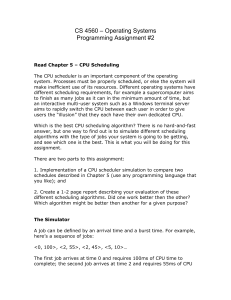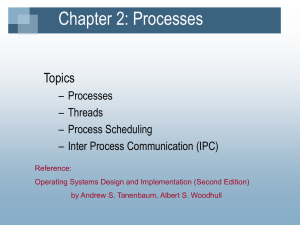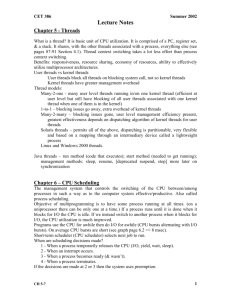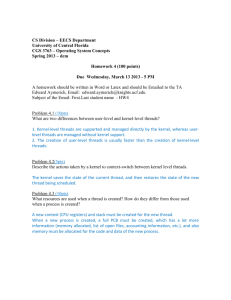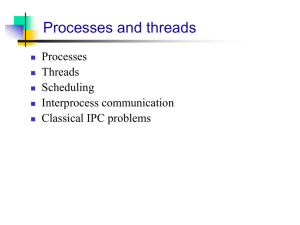BT0070A01
advertisement
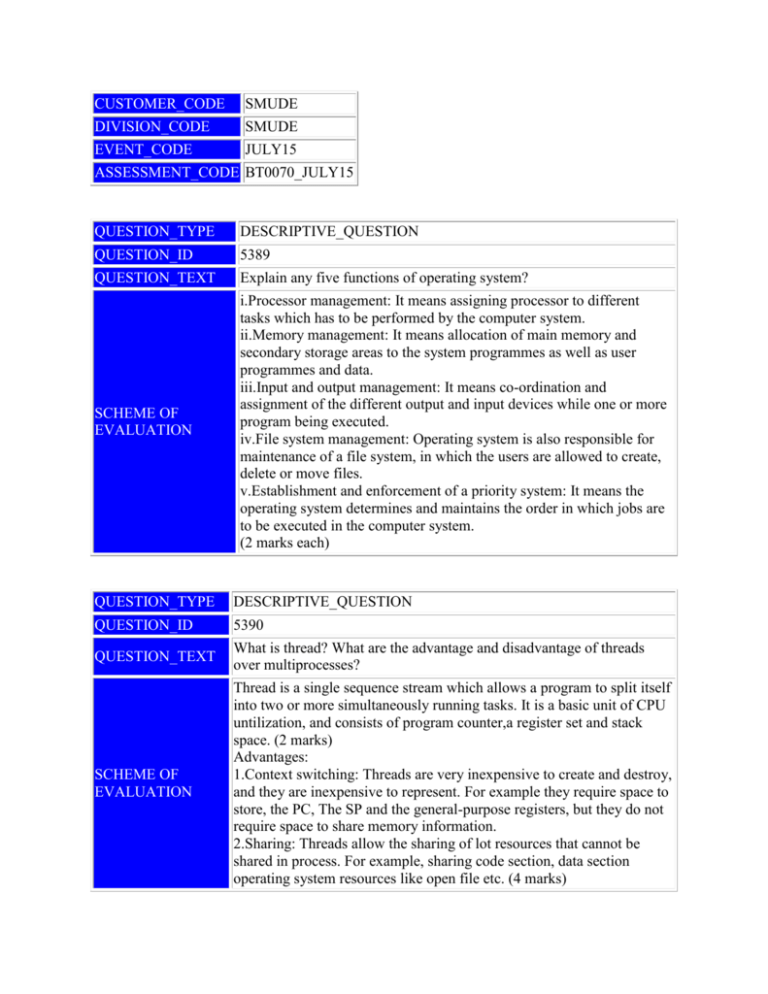
CUSTOMER_CODE SMUDE DIVISION_CODE SMUDE EVENT_CODE JULY15 ASSESSMENT_CODE BT0070_JULY15 QUESTION_TYPE DESCRIPTIVE_QUESTION QUESTION_ID 5389 QUESTION_TEXT Explain any five functions of operating system? SCHEME OF EVALUATION i.Processor management: It means assigning processor to different tasks which has to be performed by the computer system. ii.Memory management: It means allocation of main memory and secondary storage areas to the system programmes as well as user programmes and data. iii.Input and output management: It means co-ordination and assignment of the different output and input devices while one or more program being executed. iv.File system management: Operating system is also responsible for maintenance of a file system, in which the users are allowed to create, delete or move files. v.Establishment and enforcement of a priority system: It means the operating system determines and maintains the order in which jobs are to be executed in the computer system. (2 marks each) QUESTION_TYPE DESCRIPTIVE_QUESTION QUESTION_ID 5390 QUESTION_TEXT What is thread? What are the advantage and disadvantage of threads over multiprocesses? SCHEME OF EVALUATION Thread is a single sequence stream which allows a program to split itself into two or more simultaneously running tasks. It is a basic unit of CPU untilization, and consists of program counter,a register set and stack space. (2 marks) Advantages: 1.Context switching: Threads are very inexpensive to create and destroy, and they are inexpensive to represent. For example they require space to store, the PC, The SP and the general-purpose registers, but they do not require space to share memory information. 2.Sharing: Threads allow the sharing of lot resources that cannot be shared in process. For example, sharing code section, data section operating system resources like open file etc. (4 marks) Disadvantages: 1.Blocking: The major disadvantage is that if the kernel is single threaded a system call of one thread will block the whole process and CPU may be idle during the blocking period. 2.Security: Since there is an extensive sharing among threads there is a potential problem of security. It is quite possible that one thread over writes the stack of another thread although it is very unlikely since threads are meant to cooperate on a single task. (4 marks) QUESTION_TYPE DESCRIPTIVE_QUESTION QUESTION_ID 73106 QUESTION_TEXT What do you mean by Time Sharing Operating Systems? Explain the reasons for building distributed systems SCHEME OF EVALUATION Multi-programmed batch systems are suited for executing large jobs that need very little or no user interaction. On the other hand interactive jobs need on-line communication between the user and the system. Timesharing / multi tasking is a logical extension of multi-programming. It provides interactive use of the system. CPU scheduling and multiprogramming provide each user one time slice (slot) in a time-shared system. A program in execution is referred to as a process. A process executes for one time slice at a time. A process may need more than one time slice to complete. During a time slice a process may finish execution or go for an I/O. The I/O in this case is usually interactive like a user response from the keyboard or a display on the monitor. The CPU switches between processes at the end of a time slice. The switching between processes is so fast that the user gets the illusion that the CPU is executing only one user’s process. (2 Marks) There are variety of reasons for building distributed systems, the major ones are : Resource sharing. If different users are connected to one another with different resources, then the user at one site may be able to use the resources available at another. Computation speedup. In distributed system, a particular computation will be partitioned into number of sub computations that can run concurrently. In addition to this, distributed system may allow us to distribute the computations among various sites. It is called load sharing. Reliability. It means in distributed system, if one site fails, the remaining sites will share the work of failed site. Communication. When many sites are connected to one another by a communication network, the processes at different sites have the opportunity to exchange information. A User may initiate file transfer or communicate with one another via electronic mail. A user can send mail to another user at the same site or at a different site. (2 Marks each) QUESTION_TYPE DESCRIPTIVE_QUESTION QUESTION_ID 73107 QUESTION_TEXT Briefly Explain four evaluation methods of Evaluation of CPU Scheduling Algorithms SCHEME OF EVALUATION Once the selection criteria have been defined, we use one of the following different evaluation methods. 1. Deterministic Modeling If a specific workload is known, then the exact values for major criteria can be fairly easily calculated, and the "best" determined. For example, consider the following workload (with all processes arriving at time 0), and the resulting schedules determined by three different algorithms: The average waiting times for FCFS, SJF, and RR are 28ms, 13ms, and 23ms respectively. Deterministic modeling is fast and easy, but it requires specific known input, and the results only apply for that particular set of input. However, by examining multiple similar cases, certain trends can be observed. (Like the fact that for processes arriving at the same time, SJF will always yield the shortest average wait time.) 2. Queuing Models Specific process data is often not available, particularly for future times. However, a study of historical performance can often produce statistical descriptions of certain important parameters, such as the rate at which new processes arrive, the ratio of CPU bursts to I/O times, the distribution of CPU burst times and I/O burst times, etc. Armed with those probability distributions and some mathematical formulas, it is possible to calculate certain performance characteristics of individual waiting queues. For example, Little's Formula says that for an average queue length of N, with an average waiting time in the queue of W, and an average arrival of new jobs in the queue of Lambda, the these three terms can be related by: N = Lambda * W Queuing models treat the computer as a network of interconnected queues, each of which is described by its probability distribution statistics and formulas such as Little's formula. Unfortunately real systems and modern scheduling algorithms are so complex as to make the mathematics intractable in many cases with real systems. 3. Simulations Another approach is to run computer simulations of the different proposed algorithms (and adjustment parameters) under different load conditions, and to analyze the results to determine the "best" choice of operation for a particular load pattern. Operating conditions for simulations are often randomly generated using distribution functions similar to those described above. A better alternative when possible is to generate trace tapes, by monitoring and logging the performance of a real system under typical expected workloads. These are better because they provide a more accurate picture of system loads, and also because they allow multiple simulations to be run with the identical process load, and not just statistically equivalent loads. A compromise is to randomly determine system loads and then save the results into a file, so that all simulations can be run against identical randomly determined system loads. Although trace tapes provide more accurate input information, they can be difficult and expensive to collect and store, and their use increases the complexity of the simulations significantly. There are also some questions as to whether the future performance of the new system will really match the past performance of the old system. (If the system runs faster, users may take fewer coffee breaks, and submit more processes per hour than under the old system. Conversely if the turnaround time for jobs is longer, intelligent users may think more carefully about the jobs they submit rather than randomly submitting jobs and hoping that one of them works out.) 4. Implementation The only real way to determine how a proposed scheduling algorithm is going to operate is to implement it on a real system. For experimental algorithms and those under development, this can cause difficulties and resistances among users who don't care about developing OS’s and are only trying to get their daily work done. Even in this case, the measured results may not be definitive, for at least two major reasons: (1) System workloads are not static, but change over time as new programs are installed, new users are added to the system, new hardware becomes available, new work projects get started, and even societal changes. (For example the explosion of the Internet has drastically changed the amount of network traffic that a system sees and the importance of handling it with rapid response times.) (2) As mentioned above, changing the scheduling system may have an impact on the workload and the ways in which users use the system. Most modern systems provide some capability for the system administrator to adjust scheduling parameters, either on the fly or as the result of a reboot or a kernel rebuild. (2.5 Marks each) QUESTION_TYPE DESCRIPTIVE_QUESTION QUESTION_ID 73111 QUESTION_TEXT What are the functions of NOS? The main functions of NOS can be summarized as follows: a. Redirection SCHEME OF EVALUATION b. Communication management c. File/printer services d. Network management QUESTION_T DESCRIPTIVE_QUESTION YPE QUESTION_ID 114058 Consider the following system state. QUESTION_T EXT a. What is the need matrix? b. Use the safety algorithm to see if the resulting state is safe? a. SCHEME OF EVALUATION b. Yes the system is in safe state.

